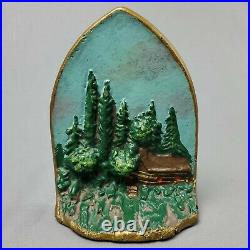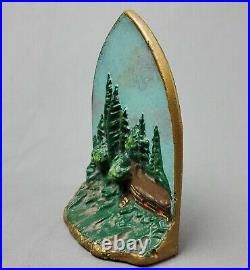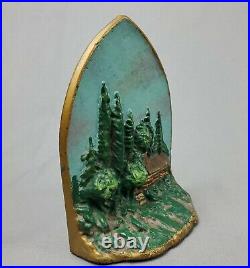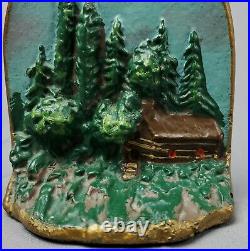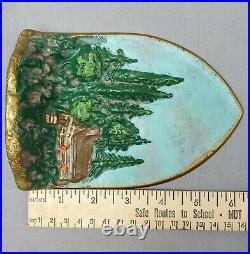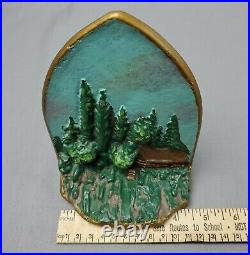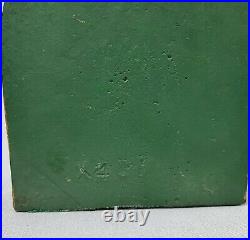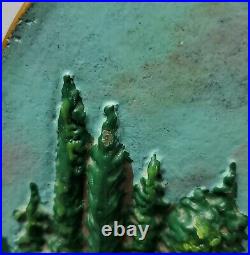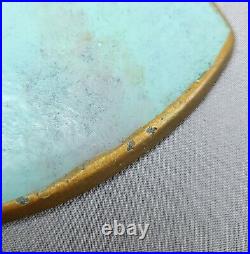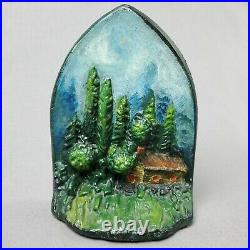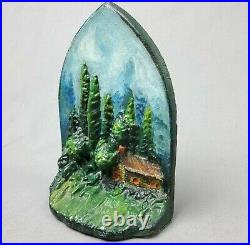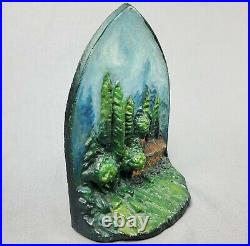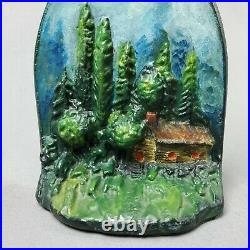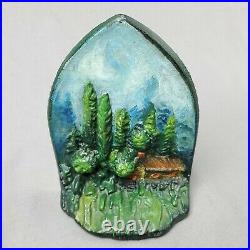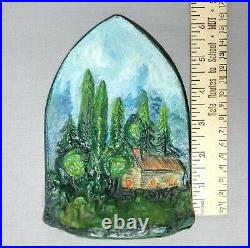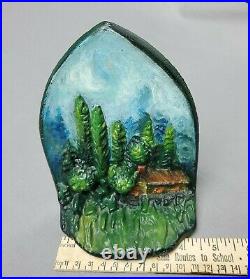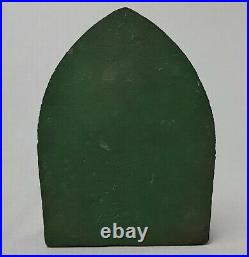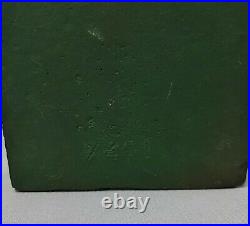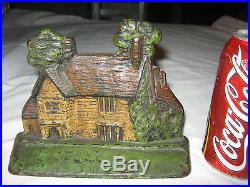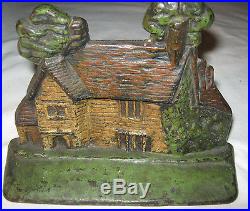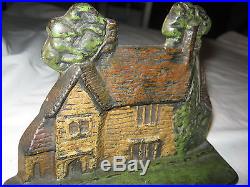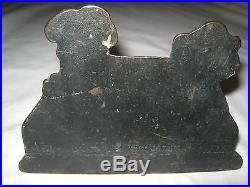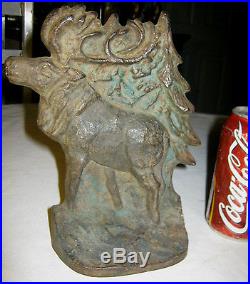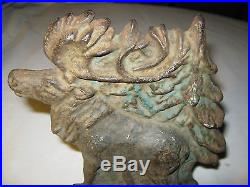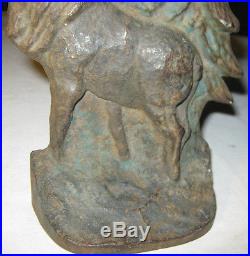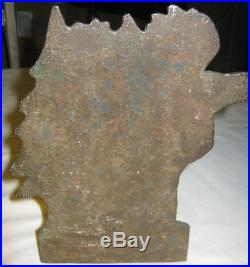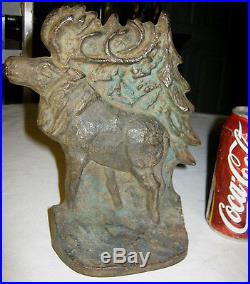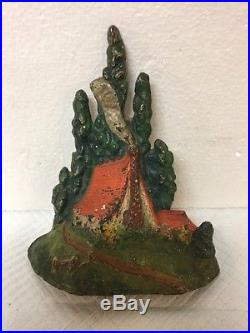
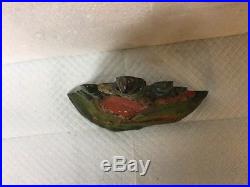
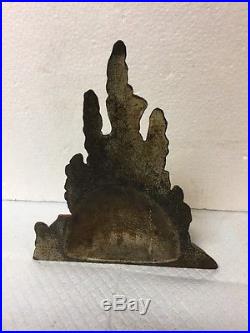
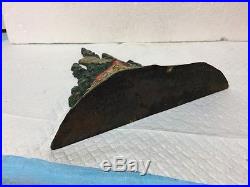
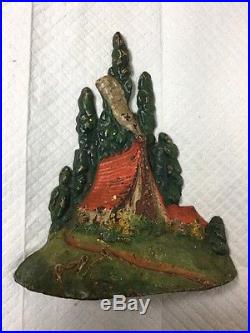
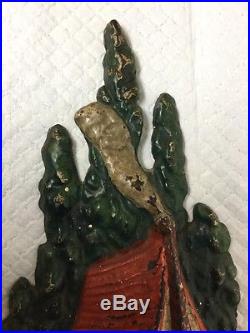
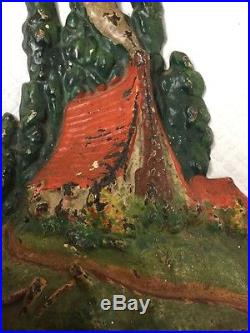
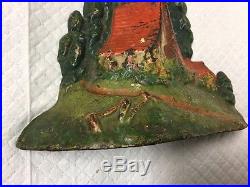
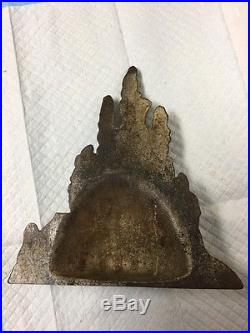
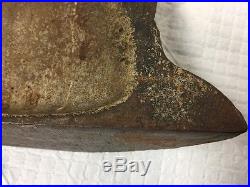
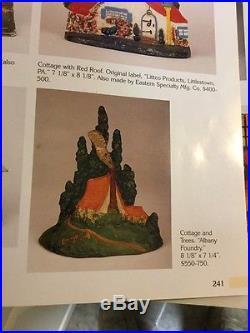

Antique Cast Iron Doorstop Cottage & Trees Albany Foundry Best Original Paint. Measures 8 1/8″ tall and 7 5/8″ wide. It is cast in raised relief with a 3-D effect. No cracks, chips or dame. All paint is genuine original with no re-paint or touch-ups. Back rear corner might have some marking but very hard to read, I guarantee it is genuine Albany Foundry. The same doorstop in exact same colors is listed on page 241 of The Doorstop Encyclopedia by Smith as shown in out last photo. Authentic early 20th century doorstop guaranteed. Leave it to the British to create a functional item that is also unique for its variety of styles and subject matter. Im referring to doorstops, or door porters, as they are called in Great Britain, the country where they originated. In Victorian times, the British manufactured large numbers of doorstops that were used to prop open heavy wooden doors to provide better room ventilation. Following in this tradition, American manufacturers produced a wide range of cast iron doorstops shaped in the form of wild and domestic animals, people, garden items, boats, windmills and houses. Many were in full figure or cast in two parts, screwed together and painted. Although production in the U. Began at the turn of the century, most doorstops were produced from the late 1920s to the mid-1940s, with the exception of the few manufacturers that remain in business today. Despite variations in design and price, all doorstops start as sand castings, or iron created by melting pure pig iron with scrap iron, then pouring the metal heated to about 2,800 degrees into a sand mold. The mold contains a cavity inside that is the identical shape of the doorstop desired. After the impression/cavity is filled with the molten iron that has cooled, the doorstop is sprayed, then hand-painted. Usually a coat of one color would be sprayed over the casting, then hand-painting was done in various colors to outline and highlight eyes and other facial features and other designs that were most prominent and detailed. Although dozens of manufacturers and foundries, produced doorstops at the turn-of-the century, there are several that are noteworthy for their designs. They include the Albany Foundry Co. Another leading firm noted for an extensive array of doorstops was A. Morris Greenblatt, the owner, was first associated in 1902 with the Nubian Art Co. And, later, the Boston Plastic Art Co. With an extensive background in design and marketing, he developed a line of doorstops that were signed and dated Greenblatt Studios. They include Dog and Duck, Halloween Cat and Lighthouse of Gloucester, Mass. Other leading firms and their wares include. Bradley and Hubbard, a firm started in 1854 by Walter Hubbard and Nathaniel Lyman Bradley in Meridan, CT. In addition to other household items like clocks, mirror frames and lamps, Bradley & Hubbard specialized in novelty art goods such as doorstops. In 1940, the Charles Parker Co. Eastern Specialty Manu-facturing Co. Located in Lancaster, Pa. Was founded in 1894 as a toy company specializing in cast iron toys. In the 1920s, the firm expanded to include the Metal Art Goods line featuring bookends, ashtrays and doorstops. The firm made doorstops until 1948 when a decision was made to sell many of the pattern molds. The wide variety and attention to detail in Hubley doorstops make them highly favored collectibles. Littco Products, the art line division of the Littlestown Hardware & Foundry, was organized in Littlestown, Pa. In 1916 and is still in business. The firm made doorstops from 1930 until 1942 when the production of metal goods for civilian use was restricted during the war. Among their most popular pieces today are Aunt Jemima, Mary Quite Contrary, Huckleberry Finn and Dutch Girl. National Foundry, located in Whitman, MA was founded in 1880, and originally known for cap pistols first made in bronze and, later, cast iron. Along with andirons, bookends and ashtrays, the firm made doorstops, which ultimately became huge sellers. The oldest maker of hand cast iron reproductions in the U. Is located in Wrightsville, Pa. During its peak production years, the firm made various doorstop designs, but is best known for doorstops including the lifelike Amish Family designs, the flat Aunt Jemima, Fireside Cat, Persian Cat, Cat on Base and Bulldog. Other companies that produced doorstops from the early 20th century until the 1940s include Sculpted Metal Studios, Guilford CT. Virginia Metalcrafters, Waynesboro, Va. And Vindex, Belvedere, IL. As part of the manufacturing process, designers often copyrighted their designs and sometimes their names on doorstops. Fish, a popular English cartoonist of the 1920s, was commissioned by Hubley to design six doorstops: The Tiger, Parlor Maid, Messenger Boy, Bathing Girls, Charleston Dancers and Footmen. Hubley also commissioned Grace G. Drayton to design several very popular doorstops, including Twin Cats, Bobby Blake, Dolly, Lil Red Riding Hood, Dolly dimple and Peter Rabbit. The name of yet another designer, Edward Cook, appears as E. Cooks design include Dachshund, Monkey on Barrel, Fawn, Koala, Parrot and Penguin. As with many collectibles today, its important to identify reproductions. Which still manufactures these doorstops. In identifying reproductions, study the casting. Old doorstops usually have a smooth finish. If cast in two pieces, the seams will fit almost perfectly. Most reproductions are rough and grainy-looking. If the surface looks like sandpaper and the seams are uneven, it is likely a recent casting. Another hint is the finish. If the paint looks bright and freshly applied, be wary. It may be a repaint or a reproduction. As mentioned earlier, prices of doorstops vary. Three factors affect the value: Rarity, condition and desirability. Mint condition items are rare and expensive, while items in good condition with some wear are still desirable. Items rated in less than good condition drop drastically in price. Such is the case with repainted items or those that are poorly painted. In caring for doorstops to ensure preservation of the finish, use caution while cleaning. To bring out colors and details, cotton swabs moistened with a mild furniture spray wax can be used if the paint is original, in good condition and has only dust or dirt on it. A toothbrush along with lukewarm water and a mild soap can be used for caked-on dirt. If a doorstop has been repainted, its best to have an expert remove paint layers to avoid removing the original paint finish. For more information on doorstops, the book Doorstops: Identification and Values by Jeanne Bertoia is an excellent guide. The item “Antique Cast Iron Doorstop Cottage & Trees Albany Foundry Best Original Paint” is in sale since Sunday, March 12, 2017. This item is in the category “Antiques\Decorative Arts\Metalware”. The seller is “spooknook” and is located in Weymouth, Massachusetts. This item can be shipped worldwide.
- Type: Doorstops
- Primary Material: Cast Iron
- Original/Reproduction: Original

